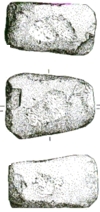


Banc Tynddol Roman and Early Medieval Lead smelting [SN 809 748]
When John Leland, the King’s Antiquary under Henry VIII, passed through the Ystwyth
Valley sometime between 1536 and 1539 as part of his survey of the monastic lands
of the nearby Strata Florida Abbey, he referred to the mining on this hill and Graig
Fawr (to the west) as well as to the evidence for former lead smelting within the
general vicinity. The geologist O.T.Jones in 1921 noted the traces of smelting debris
at Penguelan in the valley bottom, and this site was then re-
Excavations carried out in 1999 and again in 2002 and 2003 revealed the destroyed
and strewn remnants of at least three Early Medieval wind-

A geophysical magnetic susceptibility survey carried out in 2002 suggested the existence
of another type of furnace (PSS4) which on excavation proved to be a clay and stone-

This hearth which appears to have been used on several different occasions was worked
in a quite different way. This produced a lead-
This website was made possible by a grant from the Cambrian Archaeology Association


Plans and sections of the Roman hearth.
Sites of Medieval and Roman hearths and lead channel associated with the Roman pit bole.
